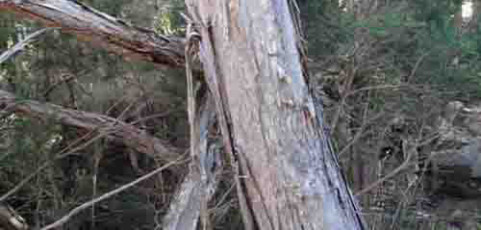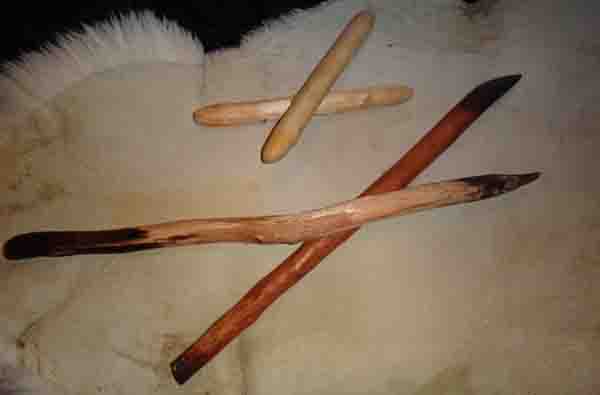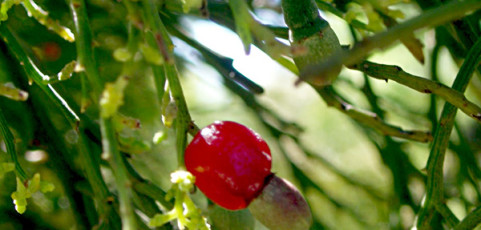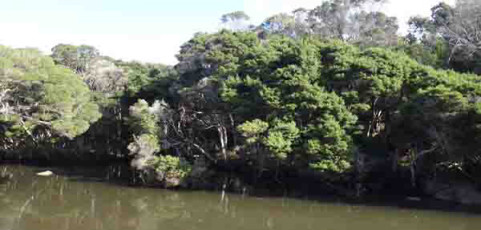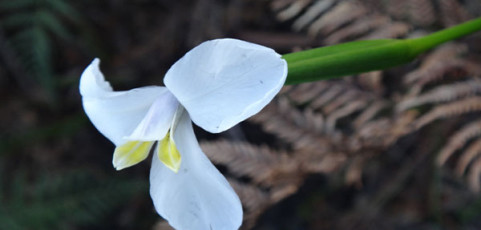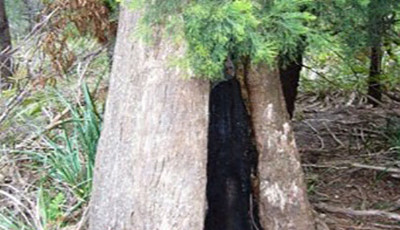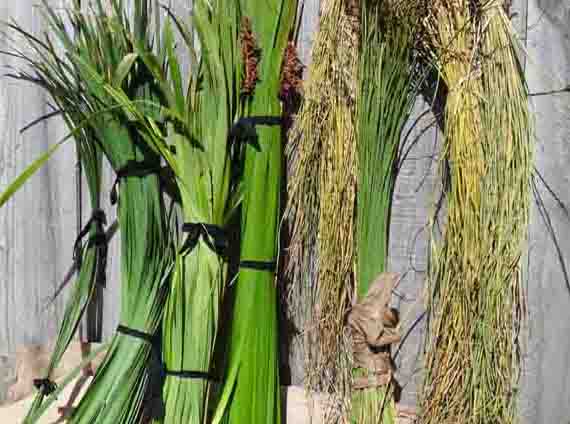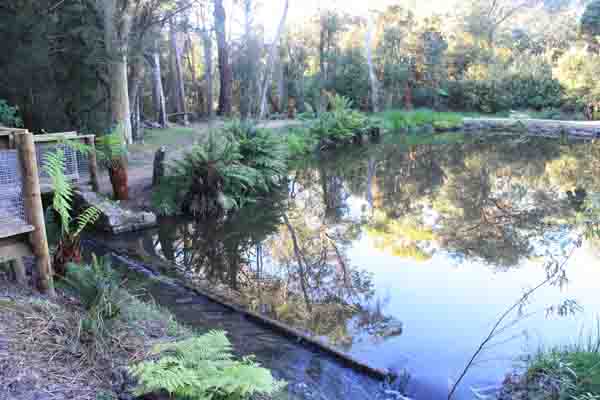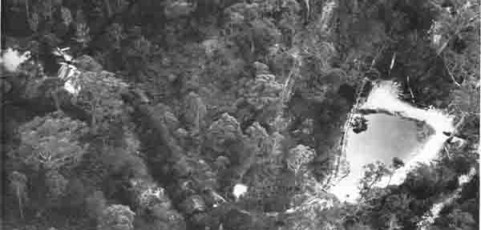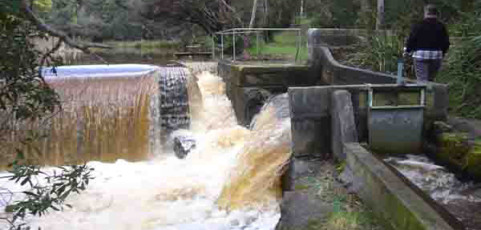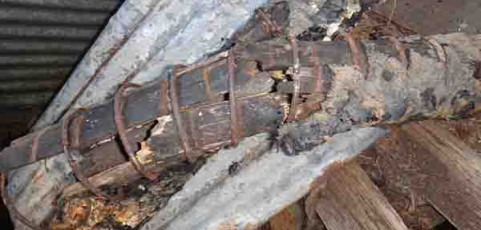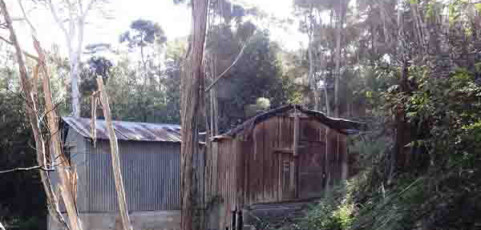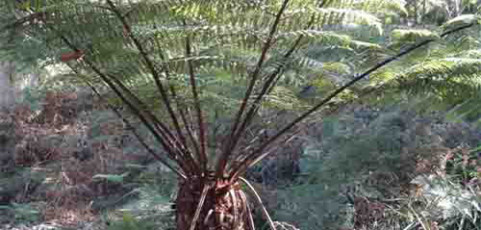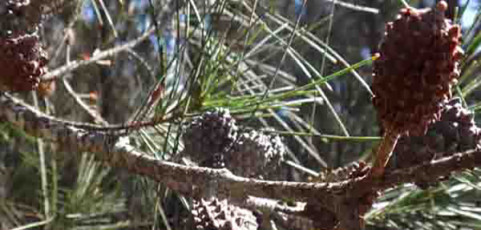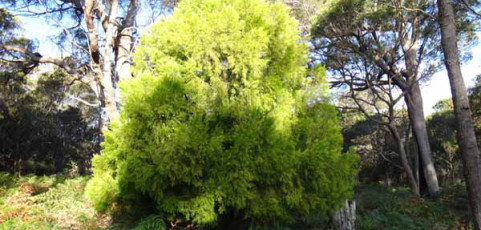Canoes were constructed from the paperbark tree which was in plentiful supply in the area. They were probably up to 5 metres long and made from thin strips of the bark tightly bound and lashed together with string for strength. Canoes were used to travel both long and short distances to the offshore islands.
Firebrand-and-Music-Sticks
Wood from dogwood and manuka was gathered to make implements and weapons. The ends were fire hardened and then made into short chisel type digging sticks, firebrands, spears, music sticks and waddis. The firebrand was carried for protection against the bad spirits as the people travelled, and for immediate use in cooking, firing the land and as well as for warmth.
Native Cherry
A variety of bush foods; fruits, roots, tubers were significant sources of nutrition for the leenerrerter people and were collected by the women.
Brid River
Living near or in the river systems of the Coastal Plains were a variety of animals including snakes, echidna, eels, native cat (quoll), platypus, possums, fish, burrowing and freshwater crayfish. Most of these animals comprised an important part of the leenerrerter diet.
White Flag Iris
Read MoreBlack peppermint
Grandfather and grandmother peppermint gum were culturally significant to the leenerrerter clanspeople both as a ceremonial tree and burial tree, and remain so for their descendants . The leenerrerter people practiced complex forms of reverence towards the remains of the dead. One practice was to place the deceased in an upright position in the burnt-out hollows of the living peppermint gum using lengths of brushwood or spears. Strips of...
Plant fibres for basket making
Read MoreSettling Pond
The settling pond was excavated in 1962 and used in the operation of the fish farm downstream. Aerial view settling pond, 1962 Before the pond was built the water race would frequently block with gravel and sand. Fish farm workers had to clean the race daily. With the settling pond as a part of the system, the water was then diverted into the pond from the race, and the gravel or sand would drop down and ‘settle.’ A screen was...
Aerial view settling pond 1962
In 1962 the settling pond was dug just a few hundred metres downstream from the weir. The water was diverted before it travelled down the race to the fish farm. The gravel and sand would drop to the bottom and the water was reasonably clear. A screen was installed to catch rubbish to stop it going down the race.
Weir and Water Supply System
Originally the water was pumped some 3000 ft or around 900 metres to the reservoir at the top of the town with no running costs. The reservoir is about 270 feet or about 80 metres above the river. The scheme covered an area from just south of the river along to the old pier. It also included taps along the foreshore, the recreation ground, (village green) and the public hall.
Water Supply Pipes
The pipes that carried the water were constructed of wood staves, wrapped in heavy gauge steel coil, and then covered in creosote soaked canvas. Throughout the 1920s, local residents had agitated for an up to date water supply and holiday makers had long complained about poor facilities. Water had been a scarce commodity in Bridport particularly during summer. Tanks would often run dry and water was carted from above the tidal flow further...
Pump House
By the early 1950s it gradually became clear that Bridport’s water supply system needed upgrading as the town continued to grow. The pump was often broken down and many attempts were made to repair it. Water supplies were inconsistent and not able to deal with growing demand. A new motor was installed in 1952 with only limited success. By the 1960’s a new pump house was installed near the Elizabeth street entrance. This is still...
Spiky Tree Fern
The hardy and adaptable Cyathea australis or Spiky tree fern is found at Tree Fern Gully on the River-Forest section of the circuit. It has roots and hair like follicles on its trunk giving it a rough texture and it is adaptable to a variety of climates and soils. Ferns are also amongst the oldest plants in the world dating back to the Carboniferous period 360 million years ago and the Spiky Tree fern is wholly protected in...
Sheoak closeup
The She-oak ( Allocasuarina littoralis ) ‘closed’ forests are remarkably quiet. It is the most drought resistant tree in Tasmania. The needle like foliage is a dull dark grey. The fallen needles create a soft cushioning mat.
The Native Cherry
The Native Cherry (Exocarpus cupressiformis) tree is a semi-parasitic plant. It attaches to the roots of the dominant black peppermint eucalypt trees around it. It is an attractive conical shaped tree with bright green dense foliage.

